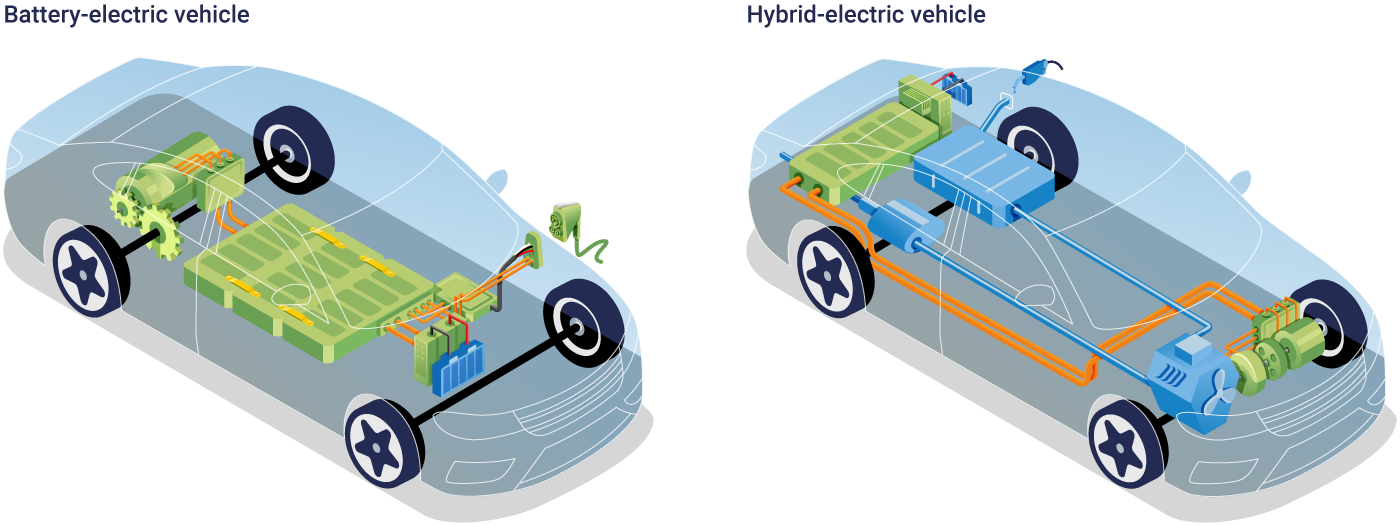Overview
There are more electric and hybrid-electric vehicles on our roads than ever before. Understanding how these vehicles – ranging from compact cars to pickup trucks – work and how they differ from gasoline-engine vehicles is important. We also have information on how to safely operate these vehicles, how they contribute to fuel and cost savings, and how the vehicles are more environmentally friendly than conventional gas-powered vehicles.
Understanding EVs and HEVs
From the outside, an electric or hybrid vehicle might look like a gas-powered vehicle, but what’s under the hood and how it operates are different. There are two types of electric vehicles and several types of hybrid-electric vehicles.
EVs
- Battery-electric vehicles, also referred to as BEVs, are powered by electricity and plug in to charge their batteries.
- Fuel cell electric vehicles, also referred to as FCEVs, are powered by hydrogen and convert the hydrogen to electricity in the fuel cell.
HEVs
- Hybrid-electric vehicles, also called HEVs, are powered by both gasoline and electricity. In many HEVs, the electric motor uses battery power to help the engine or move the vehicle independently for short distances. As the engine runs, the battery recharges. There are various levels of hybrid-electric vehicles.
- Micro HEVs have limited fuel-saving benefits from idle stop-start technology but still save on fuel compared to their gasoline-only counterparts. These vehicles don’t require the manufacturer to redesign the entire powertrain, so the vehicle cost is similar to a gas-powered vehicle. These HEVs aren’t capable of regenerative braking.
- Mild HEVs use idle stop-start technology but also can regenerate electricity when coming to a stop. Some manufacturers may also employ engine power-assist mode when propelling from a stop (but not at higher vehicle speeds).
- Medium HEVs employ idle start-stop, regenerative braking, and engine power-assist at higher speeds. These vehicles, however, aren’t equipped to propel the vehicle using only the electric motor.
- Strong or Full HEVs use hybrid vehicle functions – idle start-stop, regenerative braking, engine power-assist, and temporary (usually around 1 mile) electric-only operation.
- Plug-In HEVs, also referred to as PHEVs, use the same hybrid functions as strong HEVs but have a longer electric-only range (typically between 20 and 70 miles, depending on the vehicle design and its battery). PHEVs are an advanced hybrid-electric vehicle that plugs in to a charger to replenish the battery’s charge. Once the PHEV’s battery is depleted, the engine assists in recharging the battery for continued driving, which mirrors the operation of a strong HEV.
There are various levels of hybrid-electric vehicles. You should check how fuel efficient a particular HEV is when shopping for a new vehicle.
Various Functions of Electrified Vehicles
Just as there are various levels of hybrid-electric vehicles, various functions within an EV or HEV contribute to electrification.
- Regenerative braking: The electric motor in an electrified vehicle can be used to slow the vehicle – capturing energy in the process. This energy would otherwise be lost in the form of heat with a mechanical (conventional) braking system. The vehicle still utilizes conventional brakes to slow the vehicle during some braking events, such as emergency braking or when the battery is fully charged.
- Electric-only driving: While EVs always rely on battery power, some HEVs can also propel a vehicle using only battery power for the range of the battery – without support from the gasoline engine.
- Idle start-stop: When the vehicle comes to a stop, the HEV’s engine temporarily turns off to save fuel. The engine restarts once the driver releases the brake pedal.
- Engine power assist: During higher vehicle speeds, the electric motor can help the HEV’s engine by giving more power to propel the vehicle.
Common Components
Common electric powertrain components exist across all electrified vehicles. In battery-electric vehicles, these components replace the gasoline engine and much of its related componentry. In hybrid vehicles, these components are added to the gasoline engine and related componentry onboard the vehicle. The illustrations below outline typical component placement for both types of vehicles.

Battery Lifespan and Types
Battery-electric vehicles use battery packs to store energy and utilizes the electric motor to move the vehicle. These battery packs could last the lifespan of the vehicle, but there are many factors that could affect how long a battery lasts, according to FuelEconomy.gov and predictive modeling by the Department of Energy's National Renewable Energy Laboratory.
Most modern electric vehicle battery packs employ some form of lithium-ion chemistries, such as NMC (Nickel Manganese Cobalt) or NCA (Nickel Cobalt Aluminum); these battery chemistries use more costly materials that offer greater driving range. Another lithium-ion chemistry, Lithium Iron Phosphate (LFP), uses less costly materials that offer a moderate range with a longer cycle life.
Batteries and Temperature
EV battery packs include interconnected cells, hardware, and software to manage the battery’s operation; this is referred to as the battery management system. Temperature control is important for batteries, as extreme temperatures can affect performance and shorten a battery’s lifespan. Thermal management systems keep the batteries within the pack at an optimal temperature – even in harsher environments – but this can negatively affect your driving range since some of the battery’s energy is used for thermal management instead of motor use.
Battery and Flooding
Batteries in hybrid and electric vehicles are highly corrosive and should not be exposed to standing water. Flooded vehicles lead to high-voltage shock hazards, which could lead to a fire. If your EV has been exposed to flood conditions and you suspect your battery is damaged, contact your dealer and/or emergency services.
Charging
Today, many electric vehicles have a driving range of around 300 miles on a full charge, while some have a driving range upwards of 400 miles on a single charge. When the battery’s charge is low, the EV needs to plug into an electric power source to replenish the battery’s charge – this can occur at home, work, or any other public location along your route. However, not all vehicles and charging stations charge at the same rate. DC fast chargers can replenish your battery’s charge in under an hour, while at-home chargers may take all night to recharge your battery.
Always follow the owner’s manual and the manufacturer’s instructions regarding charging safety protocols, maintenance requirements, and related operations.
Charging Resources
Before driving an EV, it’s important to familiarize yourself with charging stations – their level of charging, plug type, and location. The U.S. Department of Transportation offers more information on electric vehicle charging speeds and plug types. Understanding EV chargers and knowing their locations along your route will help you plan when driving an electric vehicle. The U.S. Department of Energy offers more information on electric vehicle charging station locations.
Frequently Asked Questions
The following frequently asked questions may help you better understand electric vehicles.
It is important that a qualified technician with specialized EV-specific high-voltage training service your electric vehicle. A qualified technician will have the proper personal protective and testing or diagnostic equipment and an adequate understanding necessary for working on or around the high-voltage systems in your EV or HEV. Severe injury or death may result if the technician is unqualified and attempts to perform the work.
The high-voltage battery found in EVs and HEVs cannot be jumped.
However, in most cases, the 12-volt battery, which powers things like lighting and instrumentation, can be jumped — similar to that of a gas-powered vehicle. Refer to your owner’s manual for further information on jump-starting procedures and battery location.
Electric vehicles and hybrid electric vehicles require extra care when being towed because these vehicles can be damaged if towed on their drive axle (attached to an electric motor). Refer to your owner’s manual to find the best towing options for your vehicle.
An electric vehicle battery pack could last the lifespan of the vehicle, but there are many factors that could affect how long a battery lasts, according to FuelEconomy.gov and predictive modeling by the U.S. Department of Energy's National Renewable Energy Laboratory.
Yes, plug-in electric vehicle chargers are weather-resistant. Refer to your owner’s manual for further information on charging your EV.
The batteries in hybrid and electric vehicles are highly corrosive and should not be exposed to standing water. Flooded vehicles lead to high-voltage shock hazards, which could lead to a fire. Do not park a damaged vehicle with a lithium-ion battery in a garage or within 50 feet of your house, other structure, vehicle, or combustibles. If you suspect your battery is damaged, contact your dealer and/or emergency services.
- Assume the high-voltage battery and associated components are energized and fully charged. Exposed electrical components, wires, and high-voltage batteries may cause high-voltage shock hazards.
- If an emergency such as a fire occurs, contact 911 immediately. Physical damage to the vehicle or high-voltage battery may result in immediate or delayed release of toxic and/or flammable gases and fire.
- In both emergency and non-emergency situations, contact your dealer immediately.
Electric Vehicles
Safety is at the forefront of electric vehicle development. NHTSA has published:
- FMVSS No. 305a which included safety requirements to mitigate fire during normal vehicle operations, charging and post-crash, for propulsion batteries in electric vehicles.
- FMVSS No. 307 and 308, Safety Standard for the fuel container and fuel system of hydrogen powered vehicles.
The agency has launched a Battery Safety Initiative to coordinate data collection activities, research, enforcement, and safety standards to address potential safety risks relating to electric vehicles.





